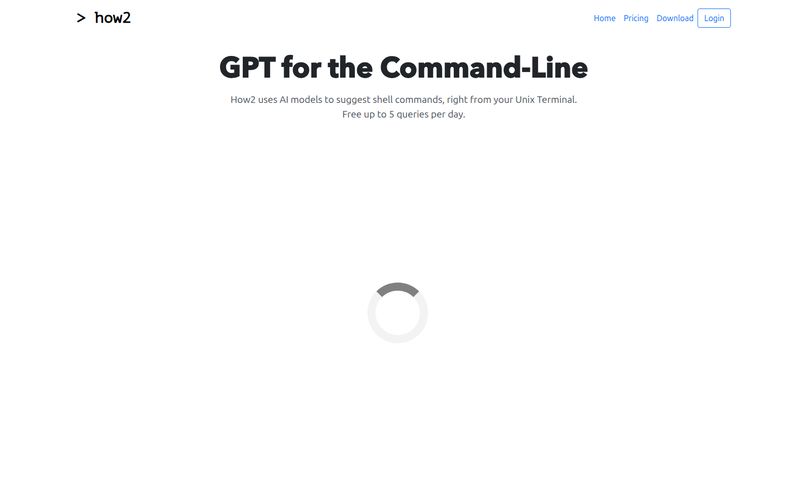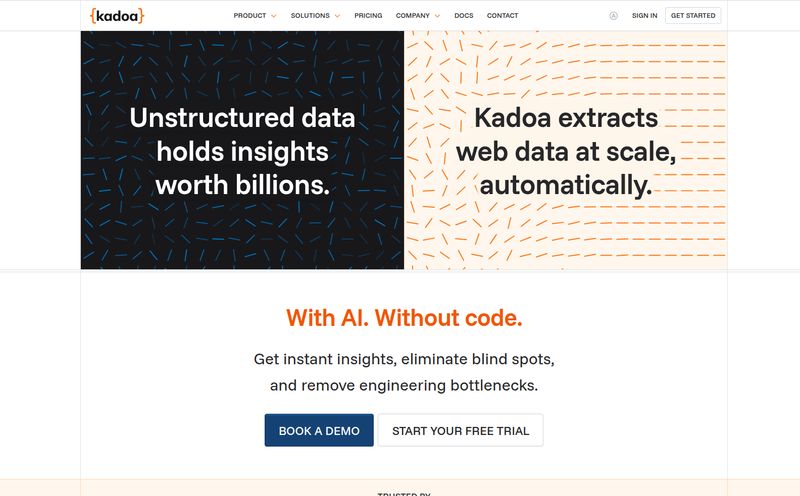I have a confession. I’ve probably abandoned more side projects than I’ve launched. It’s a familiar story for anyone in the dev world, right? You get a flash of inspiration—a brilliant idea for a SaaS tool that’s going to change everything. You’re fired up. You spend a weekend sketching out the core logic. And then… Monday hits. And you realize you have to build user authentication. And a subscription system. And a decent UI. And suddenly, your brilliant idea is buried under a mountain of what I lovingly call “the plumbing.”
It’s the great passion killer. All that foundational work that has to be done before you can even get to the fun part. The part that made you excited in the first place.
In the current AI gold rush, this problem is magnified. Everyone and their dog wants to build a custom GPT-style chatbot for a niche. The ideas are flying. But the plumbing remains as tedious as ever. That’s why my ears perk up whenever I see a tool that promises to handle the boring stuff. Which brings me to LangSaaS.
I stumbled upon it recently, and it’s not another no-code platform promising the world. It’s something different, aimed squarely at developers like us. It’s a template. A boilerlpate. A starter kit. Whatever you want to call it, it’s designed to get you from idea to a production-ready AI chatbot SaaS with way less groaning and hair-pulling. But does it live up to the hype?
So, What Exactly is LangSaaS? (And Why Should You Care?)
Let’s be clear from the get-go: LangSaaS is not a finished product you can use out of the box. It’s a set of source code—a pre-built foundation for an application. Think of it like buying a high-quality prefabricated house frame. The foundation is laid, the walls are up, and the electrical conduits are in place. You still have to do the wiring, paint the walls, and furnish it, but you’ve skipped months of messy, foundational construction.
Specifically, LangSaaS is a template for creating a personalized AI chatbot service built on a very popular and powerful architecture: Retrieval-Augmented Generation (RAG). In plain English, RAG is what stops AI chatbots from making stuff up (what we call 'hallucinating'). Instead of just relying on its general knowledge, a RAG-powered bot first retrieves relevant information from a specific knowledge base—like your company's internal documents, product manuals, or support tickets—and then generates an answer based on that context. It’s the difference between asking a random person on the street for directions and asking a local who has the map open in front of them.
LangSaaS bundles this RAG architecture with a modern tech stack: LangChain on a Python backend and Next.js for the frontend. For anyone who's been paying attention to the AI space, this is a pretty standard, and very powerful, combination.
The Good Stuff: What LangSaaS Gets Right
After poking around, a few things really stand out. This isn’t just some student project thrown on GitHub; it feels like it was built by someone who has actually felt the pain of launching a SaaS.
First and foremost, it’s a massive time-saver. The integration with Stripe is the big one for me. Setting up a payment gateway, especially for a multi-user SaaS with different plans and usage quotas, can be a real nightmare. LangSaaS has this preconfigured. That alone is worth its weight in gold. It also includes multi-user quota and credit management. That means the logic for tracking how much each user is using the service and billing them accordingly is already there. That’s not a small thing.
The tech stack is also a huge plus. It uses proven, popular tools like Qdrant for vector storage (that's the 'knowledge base' part of RAG) and is designed to work with models from providers like Cohere. Because it’s built on LangChain, it's inherently modular. So if you don't like Cohere, swapping in OpenAI or Anthropic is totally feasible, with a bit of elbow grease.
Finally, the user-facing part—the chat interface—is clean and modern because it’s built with Next.js and presumably some nice UI components like Tailwind CSS. Your final product won't look like something from 2005, which is a surprisingly common issue with developer-focused tools.
The "Hold On a Minute" Caveats
Okay, let's ground ourselves. This isn't a magic wand. LangSaaS is an accelerator, not an autopilot system. The biggest hurdle is that you need to know what you’re doing. The documentation states you need familiarity with LangChain and Python for the backend and Next.js (a React framework) for the frontend. This isn’t for a beginner who just learned what a `
This is a tool for developers who are comfortable in that ecosystem but want to skip the tedious setup phase. If you can’t `pip install` your way out of a paper bag or if the term `useEffect` gives you hives, this isn't for you. And that’s okay!
The other thing to remember is that you'll still need to do the fine-tuning. The AI elements need to be adapted to your specific workflow and data. The template gives you the engine and the chassis, but you have to tune the engine for the specific racetrack you’re competing on. You’re the one who has to curate the knowledge base and tweak the prompts to make your chatbot truly useful and not just a generic wrapper around an LLM.
A Look Under the Hood at the Core Features
Let's break down the key components you're getting in this package. It’s more than just a few scripts stitched together.
| Feature | What It Means For You |
|---|---|
| RAG Architecture | Your chatbot gives context-aware answers based on your documents, not just generic web knowledge. This is crucial for business applications. |
| Multi-User Quota Management | The system to manage multiple customers on different tiers is already built. You can define limits and track usage per user. |
| Stripe Payment Gateway | Handles subscriptions and payments out-of-the-box. This saves you weeks of development and testing headaches. A genuine game-changer. |
| Modern Chat Interface | A clean, responsive frontend built with Next.js. Your app will look professional from day one, which builds trust with early users. |
| Separated Tech Stack | With a Next.js frontend and Python backend, you get the best of both worlds: a fast, interactive UI and a powerful, data-science-friendly backend. |

Visit LangSaaS
What About the LangSaaS Pricing?
This is the million-dollar question, isn't it? As of my writing this, the official site doesn't list a public price. This is pretty common for developer tools like this, which might have different tiers or are sold as a one-time license purchase.
In my experience, templates like this can range from a few hundred dollars to a few thousand for a one-time purchase of the source code, sometimes with an option for ongoing updates. Given the feature set, especially the pre-built Stripe integration, I wouldn't be surprised to see it positioned as a premium product. Honestly, if it saves a small team a month of development time, a price tag of $500-$1500 could be an absolute steal. Your best bet is to head over to the official LangSaaS website and check for the most current information or contact them directly.
Who is This Template Really For?
After looking it all over, I have a very clear picture of the ideal LangSaaS user.
- The indie hacker or solopreneur who can code but whose time is their most valuable asset.
- A small startup or agency that wants to quickly prototype and launch an AI-powered service for a client or as a new product line.
- Any developer who understands the value of building on a solid foundation instead of reinventing the wheel for the tenth time.
It's for people who want to test a business idea in the real world, with real paying users, as quickly as possible. It's for people who want to focus their energy on what makes their chatbot unique—the data, the prompts, the specific problem it solves—not on the plumbing.
Frequently Asked Questions About LangSaaS
- Is LangSaaS a no-code tool?
- Absolutely not. It is a source code template for developers. You need strong coding skills in Python, LangChain, and Next.js/JavaScript to use and customize it effectively.
- What is RAG and why is it important?
- RAG stands for Retrieval-Augmented Generation. It allows an AI to pull information from a specific, private set of documents before answering a question. This makes the answers highly relevant, accurate, and reduces the risk of the AI making things up.
- Can I use a different language model like GPT-4 instead of Cohere?
- Most likely, yes. Since the backend is built on LangChain, which is designed for modularity, you should be able to swap out the language model. However, this will require custom code changes on your part. The template gives you a working setup with one provider, but the framework allows for flexibility.
- Do I need to host the application myself?
- Yes. You receive the source code, and you are responsible for deploying and hosting it on your own infrastructure, such as Vercel for the frontend and a service like Render or AWS for the backend.
- How complete is the Stripe integration?
- The information suggests it is 'preconfigured' and 'out-of-the-box', which typically means the webhooks, subscription logic, and user plan management are already coded. You will still need to connect your own Stripe account and run thorough tests before going live.
Final Thoughts
Look, the market is getting flooded with AI tools. It's noisy out there. But LangSaaS cuts through some of that noise by not trying to be a magical solution for everyone. It knows its audience: skilled developers who want to move fast.
It’s a pragmatic tool for a pragmatic problem. It’s not going to write your business plan for you, but it might just clear enough of the technical underbrush out of the way so you can finally build that brilliant thing you dreamed up. And for a developer with more ideas than time, that’s an incredibly compelling offer.



